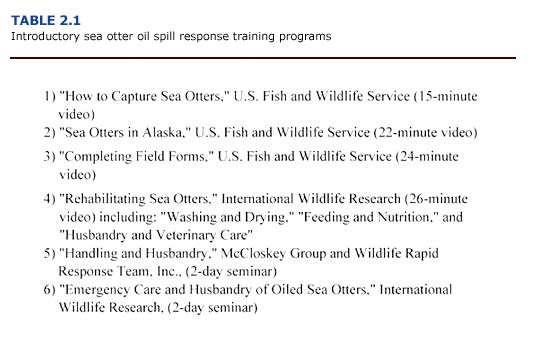Wildlife biologists from the USFWS and the CDFG have extensive experience in capturing and transporting sea otters. Their expertise has been developed through years of sea otter management and research. These experts have obtained an understanding of the sea otter’s biology and ecology, the skills required to effectively conduct capture operations, and the ability to use this knowledge for successful captures. As a result, these resource agency biologists will conduct or supervise sea otter capture and will be responsible for training additional capture personnel.
New personnel should be trained prior to an oil spill through programs approved by the USFWS or the CDFG. A training video, “How to Capture Sea Otters,” has been prepared by the USFWS. Additional training videos concerning sea otter natural history, husbandry, and rehabilitation methods (Table 2.1) are currently available. To maintain proficiency in the capture and handling of sea otters, trained personnel should participate in regular oil spill exercises conducted by USFWS, the oil industry, and wildlife task groups.

Three levels of expertise may be involved in a capture operation: volunteer or amateur participants, technical professionals, and scientific professionals. The volunteer or amateur has no previous training in either oil spill response or in marine mammal biology, capture, handling, or rehabilitation. They should not be directly involved in capture operations. However, they may be assigned to assist specific technical or scientific personnel who will be responsible for their training and supervision.
Technical professionals include vessel operators, marine electricians, marine mechanics, etc. They are responsible for vessel and aircraft operation, safety and navigation, as well as mechanical repairs, net repairs, and maintaining supplies. Animal handling by this group must be supervised by the scientific professionals.
Scientific professionals are those trained in such disciplines as biology, ecology, veterinary medicine, etc. They are responsible for capturing the sea otters and coordinating all record keeping. If proficiency training is necessary, capture personnel should participate in annual government and industry-sponsored oil spill drills involving sea otter capture scenarios.
To prevent injury to personnel and animals, newly trained members of the capture team should be supervised by experienced wildlife biologists. Only experienced professionals should operate boats and aircraft. All personnel should be trained in first aid, water safety, and cardiopulmonary resuscitation through U.S. Coast Guard, and American Red Cross courses. This basic knowledge is mandatory for all sea otter capture personnel.

